What Makes a Front-of-Pack Nutritional Labelling System Effective: The Impact of Key Design Components on Food Purchases
Abstract
1. Introduction
2. Materials and Methods
2.1. Typology of Front of Pack Labeling System
2.1.1. Directiveness
2.1.2. Scope and Gradation
2.1.3. Set of Reference
2.1.4. Sign
2.2. The Experiment
2.2.1. Seven FoPLs Prototypes
2.2.2. The Laboratory Store
2.2.3. The Experimental Design
2.2.4. Data Analysis
3. Results
3.1. Directiveness: A Food-Directive System Does Better than a Diet-Directive System
3.2. Scope and Gradation: Better to See at Once What to Avoid and What to Favour
3.3. Set of Reference: Same Global Effect, But Contrasting Behavioural Responses
4. Discussion
5. Conclusions
Author Contributions
Funding
Acknowledgments
Conflicts of Interest
Appendix A. Examples of Labelling Nutrition Schemes in Use (or Consideration)
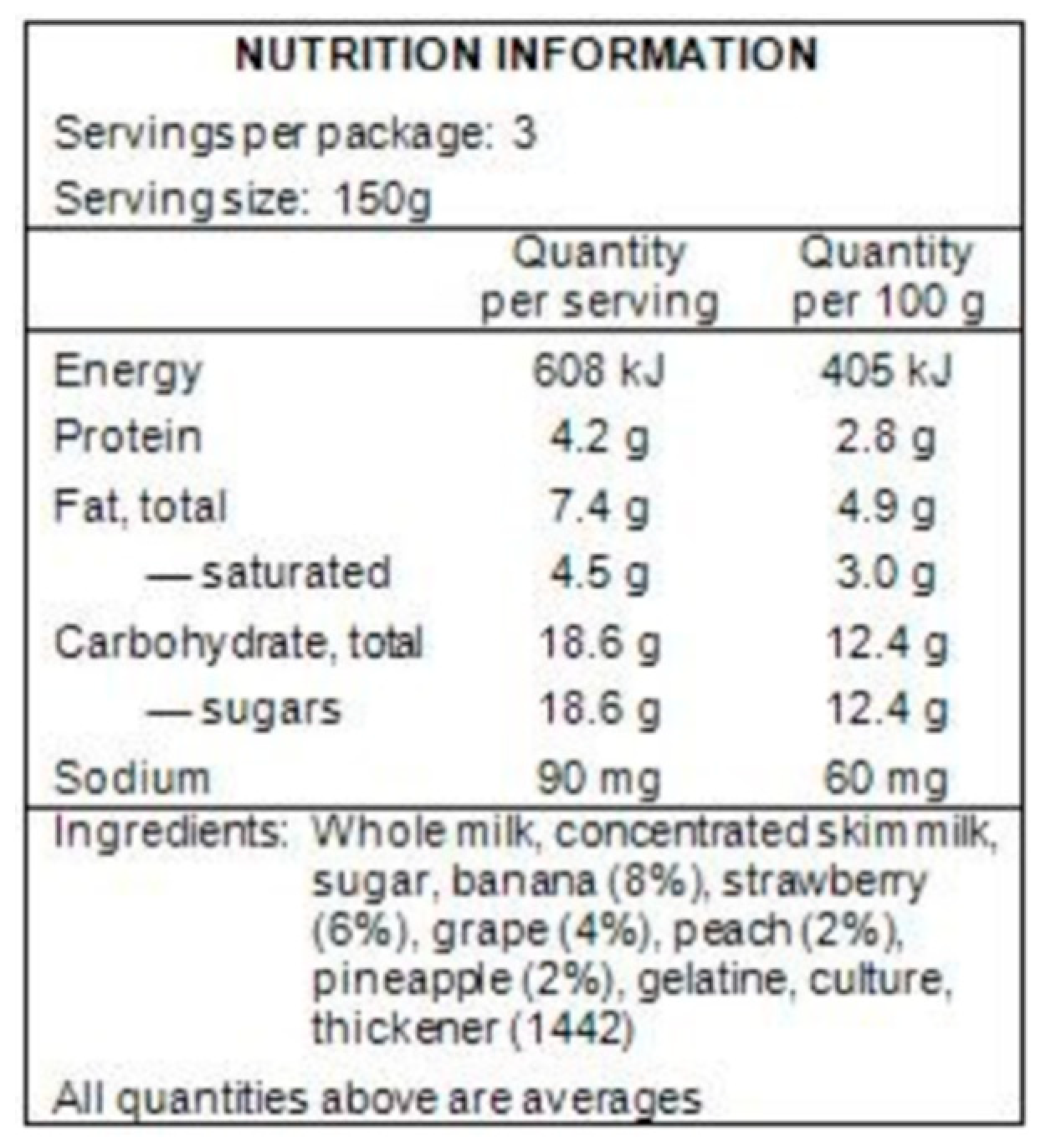
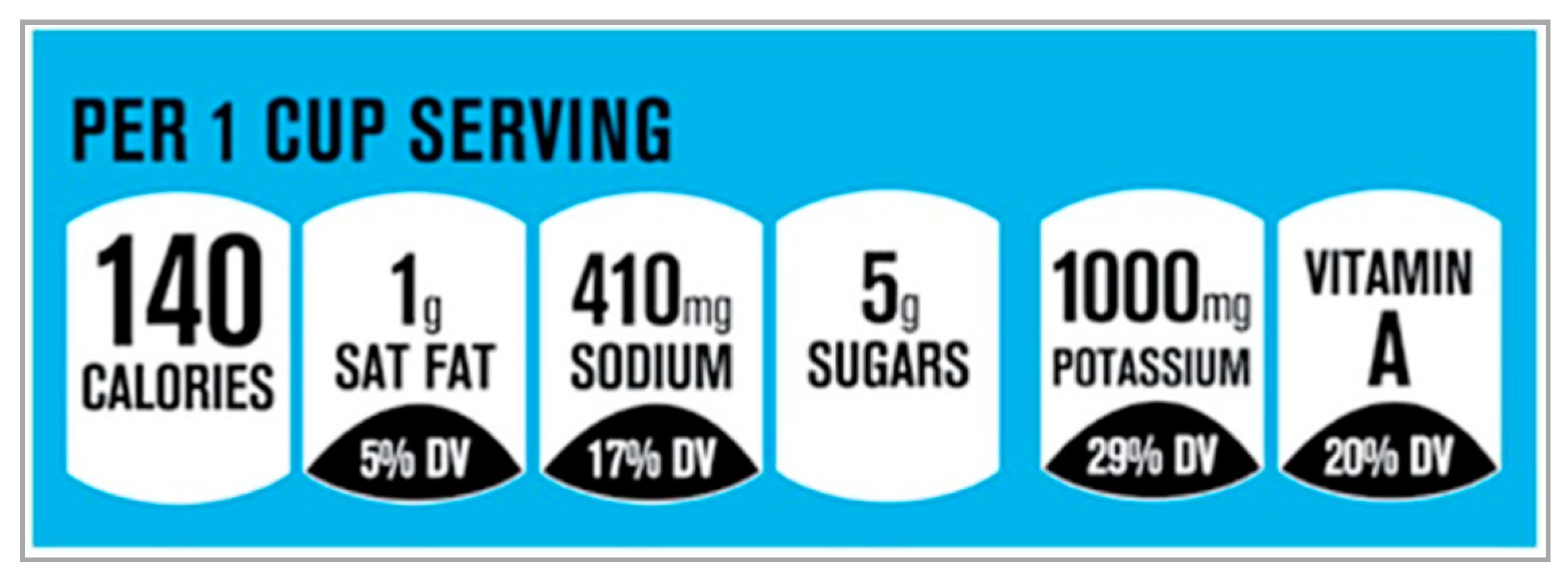



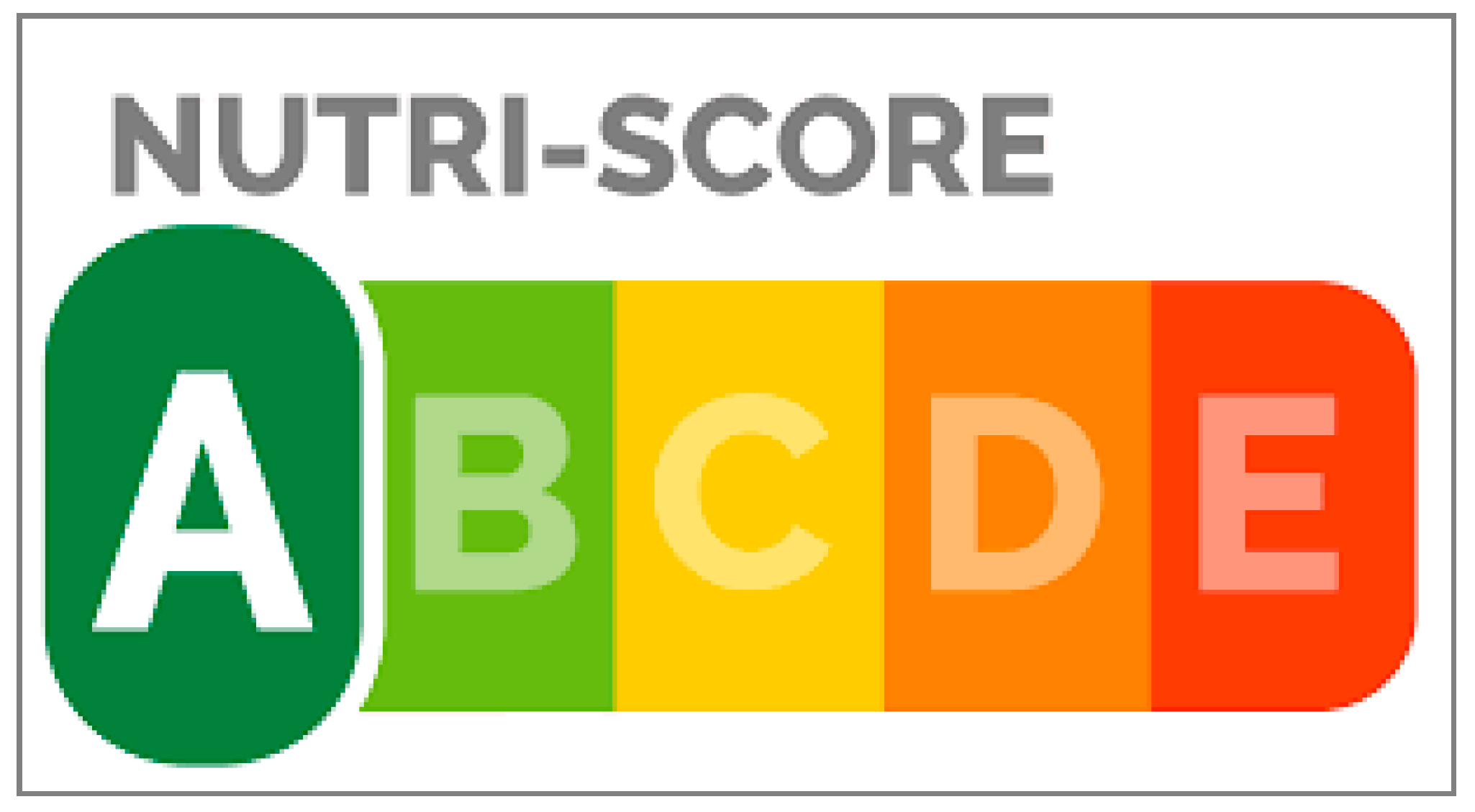
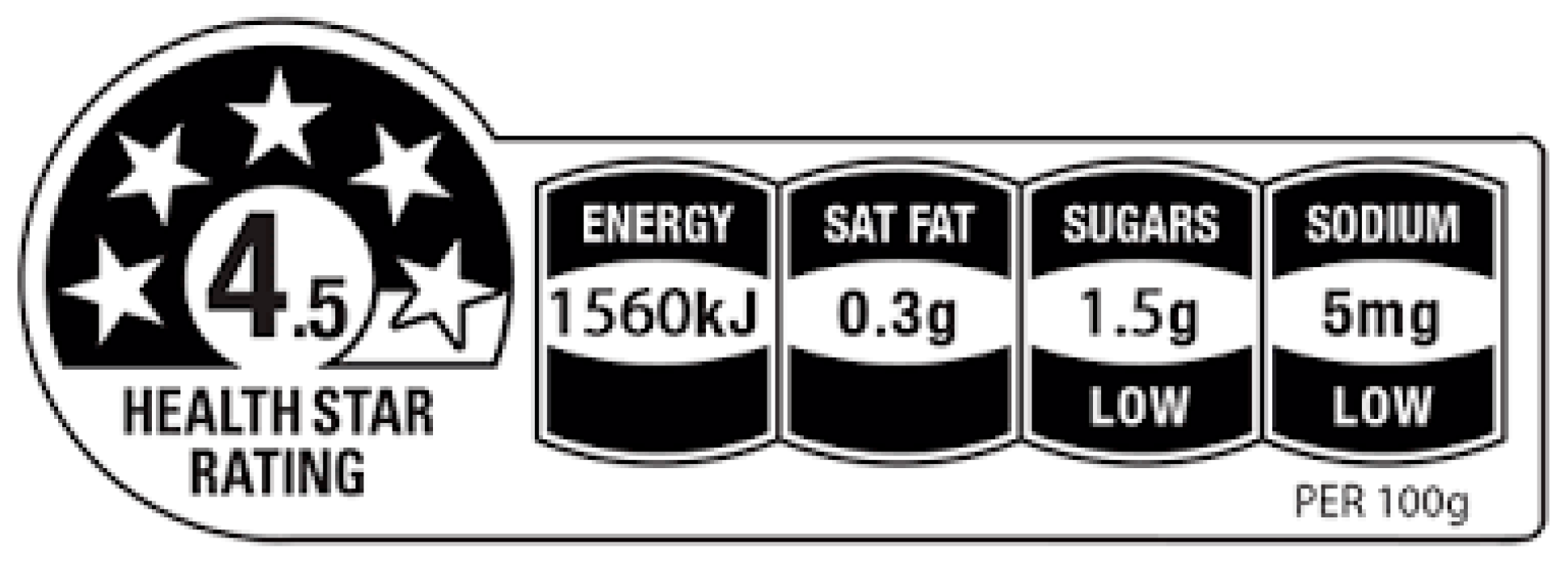

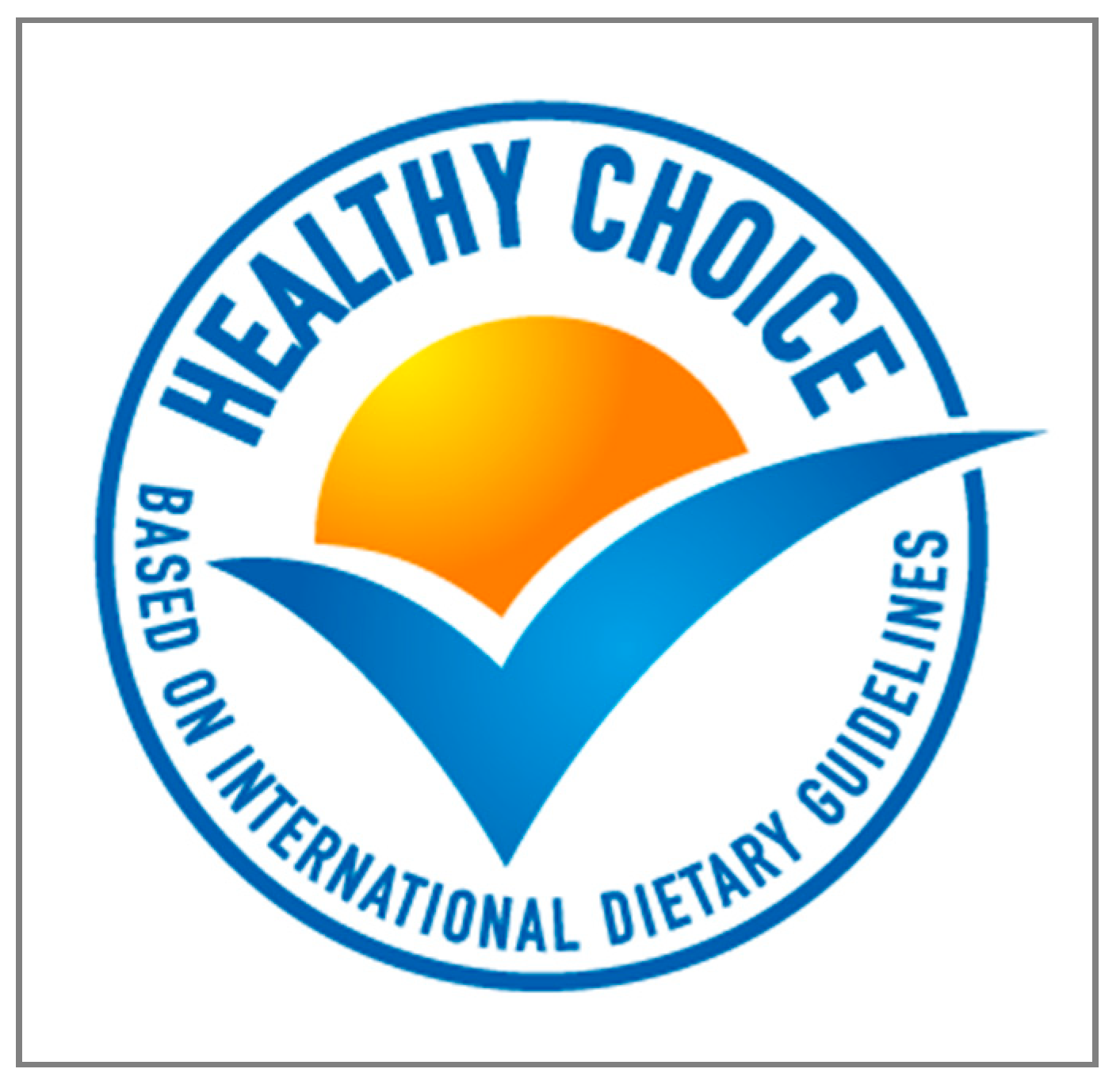
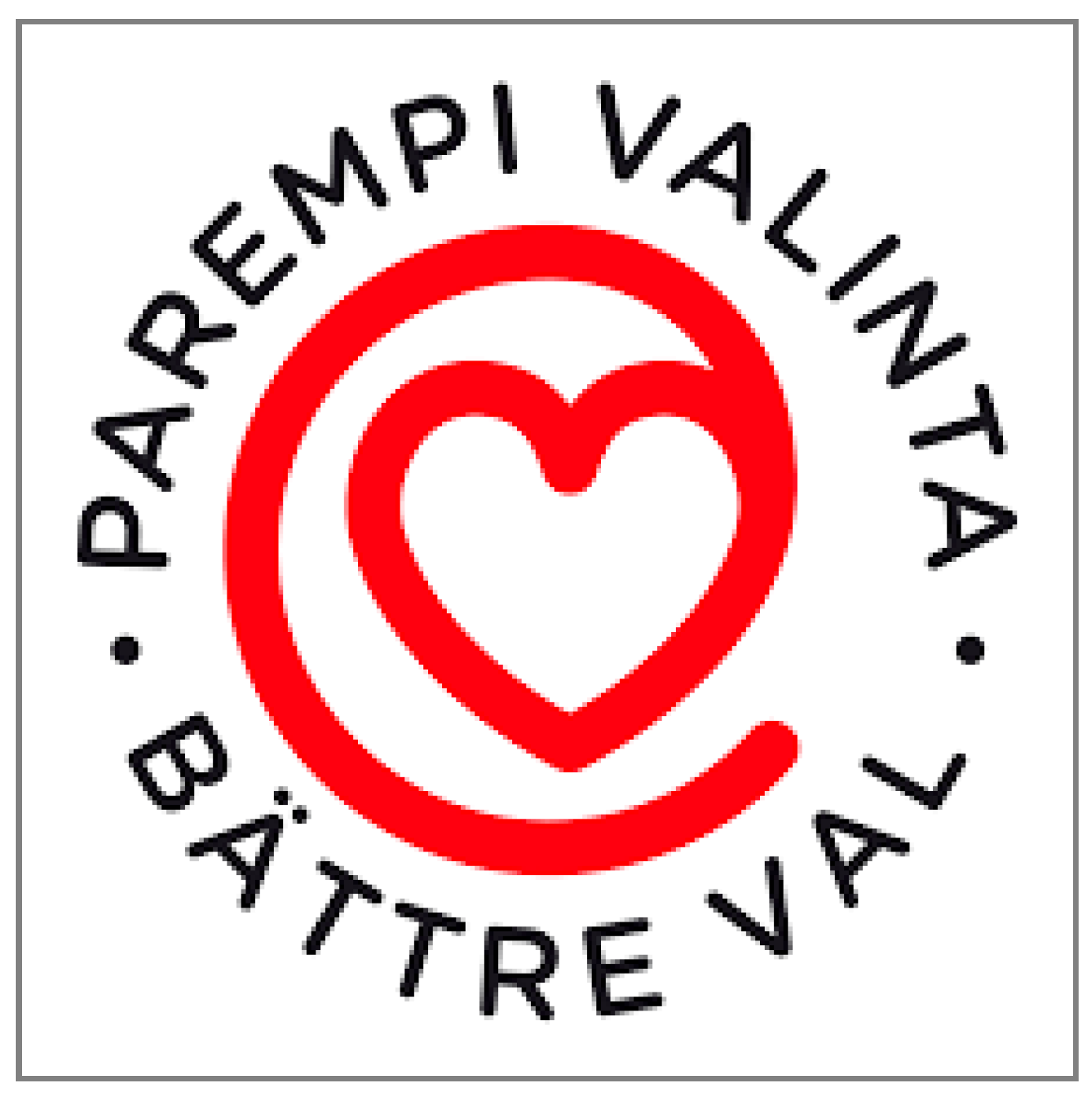

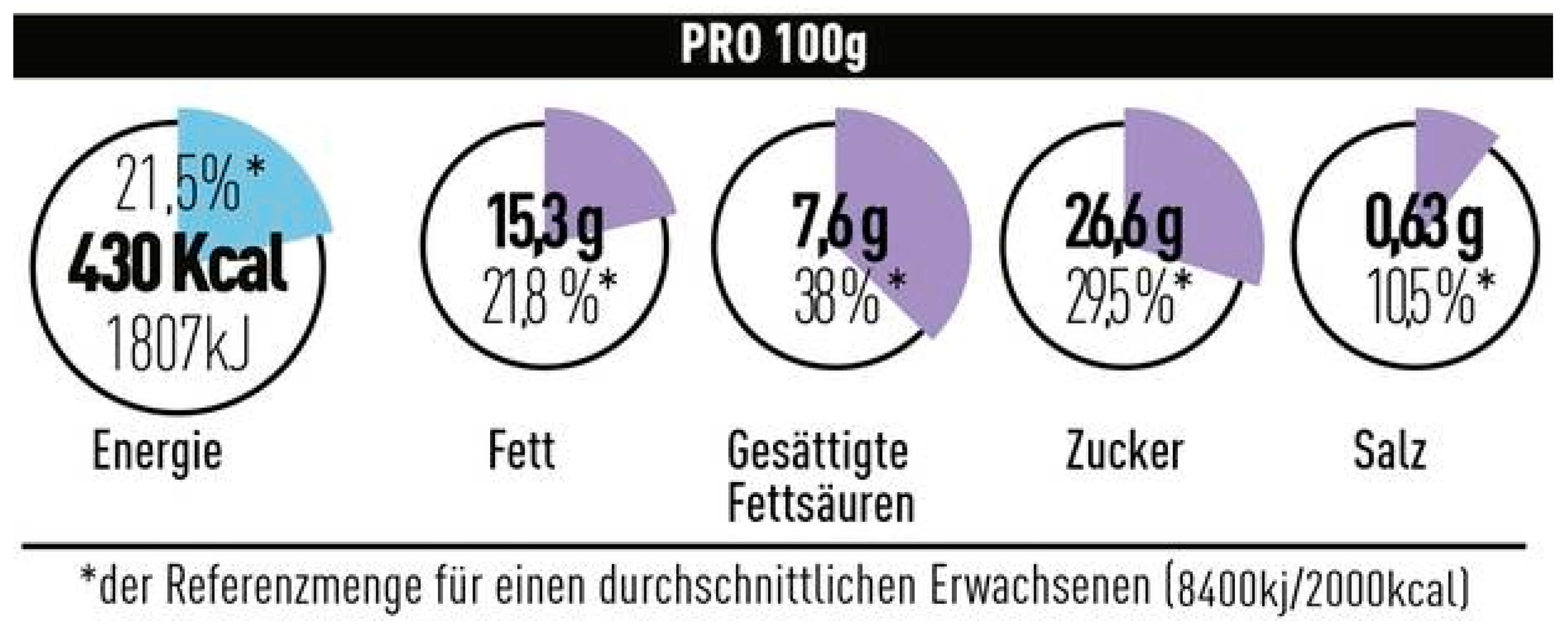

Appendix B
| DIRECTIVENESS | Non-Directive—Reference Intakes | 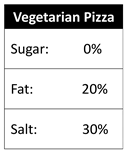 | |||||
| Food-Directive | Diet-Directive | ||||||
| Directive | SET OF REFERENCE | Within-Category | SCOPE and GRADATION | Recommended |  | 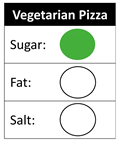 | |
| Recommended and Warned |  | Not tested | |||||
| Across-Category | SCOPE and GRADATION | Recommended |  | 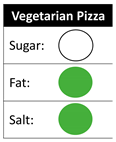 | |||
| Recommended and Warned |  | Not tested | |||||
Appendix C

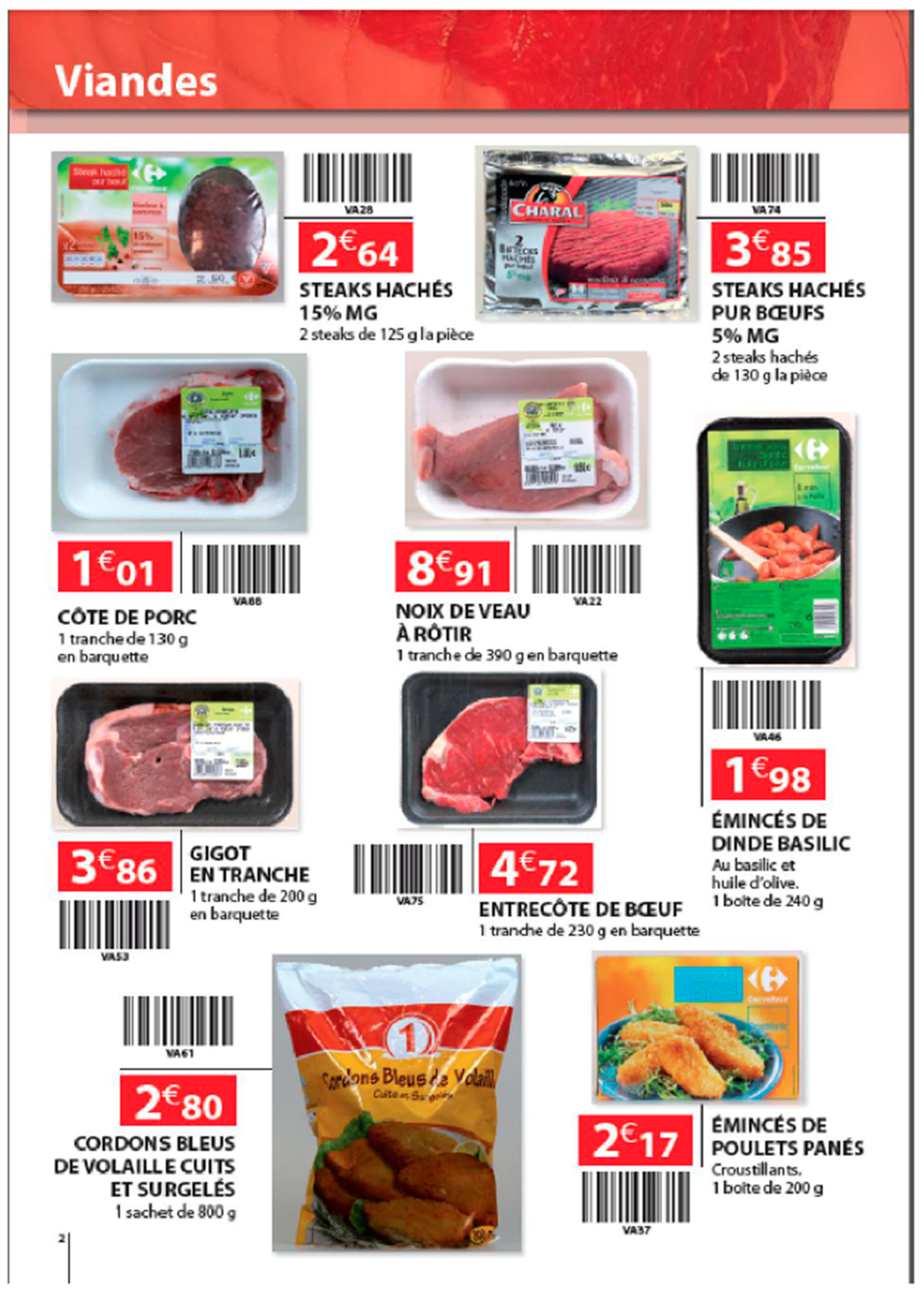
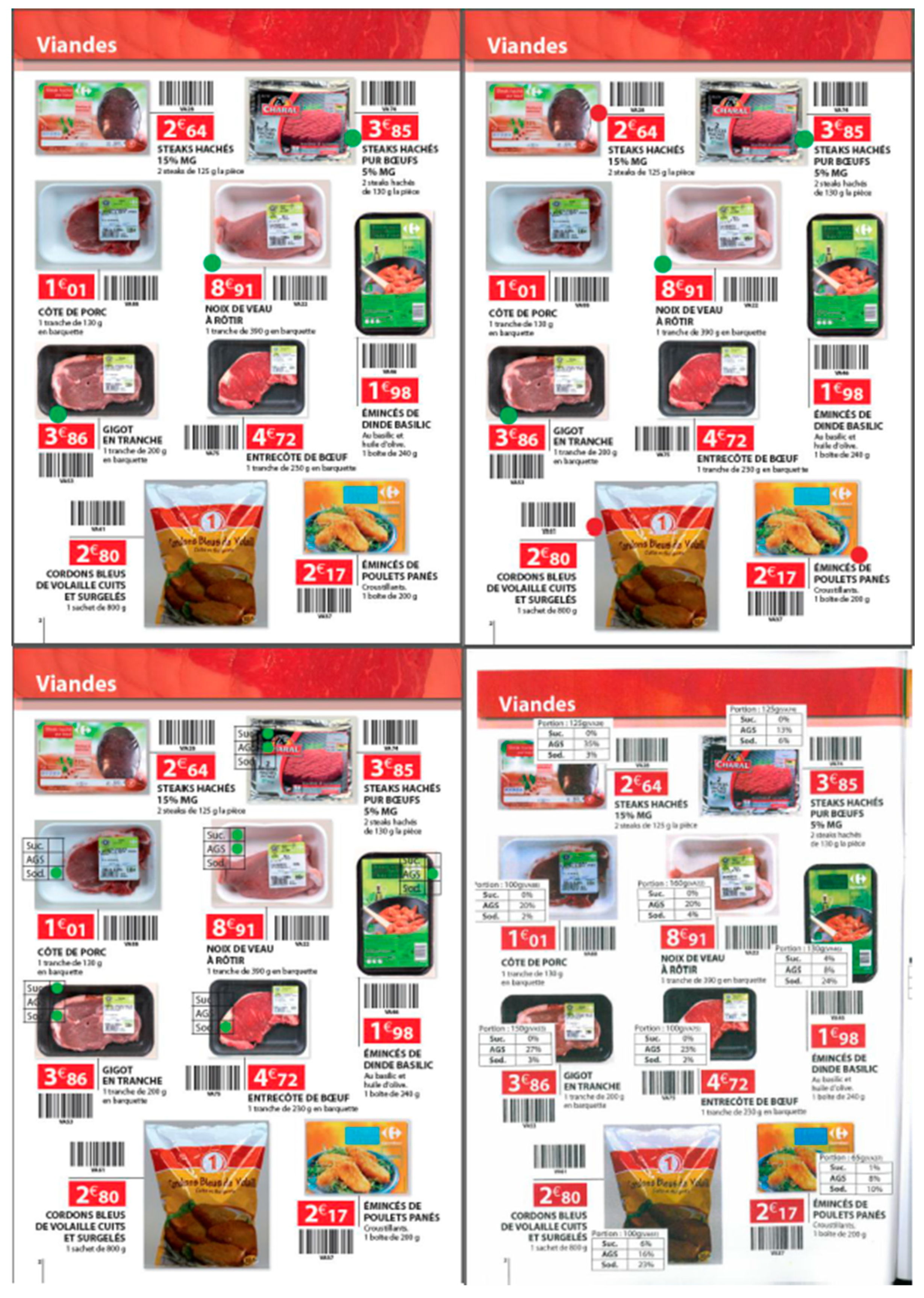
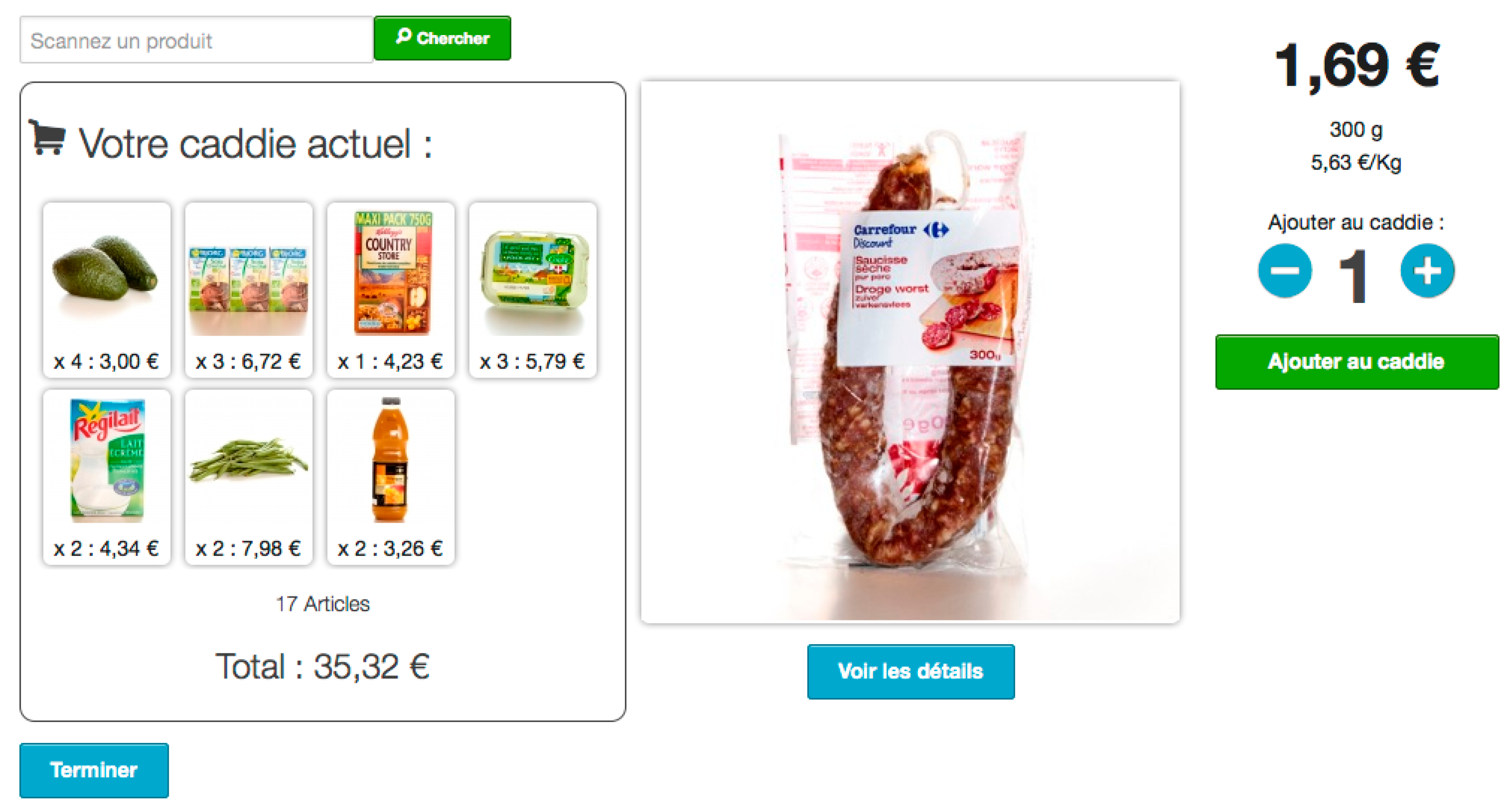
Appendix D
| Labelling Scheme | Number of Subjects | Sample Composition | |||
|---|---|---|---|---|---|
| Women | Age | Income EUR* | BMI | ||
| RI | 52 | 75% | 39.5 | 1246 | 22.2 |
| D-W-R | 70 | 82% | 39.7 | 1326 | 23.8 |
| D-A-R | 75 | 80% | 40.5 | 1250 | 24.3 |
| F-W-R | 59 | 74% | 41.5 | 1290 | 25.4 |
| F-A-R | 52 | 90% | 41.3 | 1155 | 23.8 |
| F-W-R&W | 29 | 83% | 43.0 | 1366 | 23.9 |
| F-A-R&W | 27 | 96% | 39.2 | 1134 | 23.2 |
| Total | 364 | 82% | 40.6 | 1258 | 23.9 |
References
- Bonsmann, S.S.G.; Ciriolo, E.; van Bavel, R.; Wollgast, J. Front-of-Pack Nutrition Labelling Schemes: A Comprehensive Review; EUR 29811 EN; Publications Office of the European Union: Luxembourg, 2020. [Google Scholar]
- Thow, A.M.; Jones, A.; Schneider, C.H.; Labonté, R. Global Governance of Front-of-Pack Nutrition Labelling: A Qualitative Analysis. Nutrients 2019, 11, 268. [Google Scholar] [CrossRef]
- Draper, A.K.; Adamson, A.J.; Clegg, S.; Malam, S.; Rigg, M.; Duncan, S. Front-of-pack nutrition labelling: Are multiple formats a problem for consumers? Eur. J. Public Health 2013, 23, 517–521. [Google Scholar] [CrossRef] [PubMed]
- Goiana-Da-Silva, F.; Goiana-Da-Silva, F.; Miraldo, M.; Calhau, C.; Bento, A.; Cruz, D.; Almeida, F.; Darzi, A.; Araújo, F. Front-of-pack labelling policies and the need for guidance. Lancet Public Health 2019, 4, e15. [Google Scholar] [CrossRef]
- Kelly, B.; Hughes, C.; Chapman, K.; Louie, J.C.Y.; Dixon, H.; Crawford, J.; King, L.; Daube, M.; Slevin, T. Consumer testing of the acceptability and effectiveness of front-of-pack food labelling systems for the Australian grocery market. Health Promot. Int. 2009, 24, 120–129. [Google Scholar] [CrossRef] [PubMed]
- Mejean, C.; Macouillard; Péneau, S.; Hercberg, S.; Castetbon, K. Consumer acceptability and understanding of front-of-pack nutrition labels. J. Hum. Nutr. Diet. 2013, 26, 494–503. [Google Scholar] [CrossRef] [PubMed]
- Julia, C.; Péneau, S.; Buscail, C.; Gonzalez, R.; Touvier, M.; Hercberg, S.; Kesse-Guyot, E. Perception of different formats of front-of-pack nutrition labels according to sociodemographic, lifestyle and dietary factors in a French population: Cross-sectional study among the NutriNet-Santé cohort participants. BMJ Open 2017, 7, e016108. [Google Scholar] [CrossRef] [PubMed]
- Egnell, M.; Talati, Z.; Gombaud, M.; Galan, P.; Hercberg, S.; Pettigrew, S.; Julia, C. Consumers’ Responses to Front-of-Pack Nutrition Labelling: Results from a Sample from The Netherlands. Nutrients 2019, 11, 1817. [Google Scholar] [CrossRef]
- Möser, A.; Hoefkens, C.; Camp, J.V.; Verbeke, W. Simplified nutrient labelling: Consumers’ perceptions in Germany and Belgium. J. Verbr. Lebensm. 2010, 5, 169–180. [Google Scholar] [CrossRef]
- Cowburn, G.; Stockley, L. Consumer understanding and use of nutrition labelling: A systematic review. Public Health Nutr. 2005, 8, 21–28. [Google Scholar] [CrossRef]
- Egnell, M.; Talati, Z.; Hercberg, S.; Pettigrew, S.; Julia, C. Objective Understanding of Front-of-Package Nutrition Labels: An International Comparative Experimental Study across 12 Countries. Nutrients 2018, 10, 1542. [Google Scholar] [CrossRef]
- Balcombe, K.; Fraser, I.; Falco, S.D. Traffic lights and food choice: A choice experiment examining the relationship between nutritional food labels and price. Food Policy 2010, 35, 211–220. [Google Scholar] [CrossRef]
- Borgmeier, I.; Westenhoefer, J. Impact of different food label formats on healthiness evaluation and food choice of consumers: A randomized-controlled study. BMC Public Health 2009, 9, 184. [Google Scholar] [CrossRef] [PubMed]
- Ducrot, P.; Julia, C.; Méjean, C.; Kesse-Guyot, E.; Touvier, M.; Fezeu, L.K.; Hercberg, S.; Péneau, S. Impact of Different Front-of-Pack Nutrition Labels on Consumer Purchasing Intentions. Am. J. Prev. Med. 2016, 50, 627–636. [Google Scholar] [CrossRef] [PubMed]
- Waterlander, W.E.; Steenhuis, I.H.; de Boer, M.R.; Schuit, A.J.; Seidell, J.C. Effects of different discount levels on healthy products coupled with a healthy choice label, special offer label or both: Results from a web-based supermarket experiment. Int. J. Behav. Nutr. Phys. Act. 2013, 10, 59. [Google Scholar] [CrossRef] [PubMed]
- Hamlin, R.; McNeill, L.S.; Moore, V. The impact of front-of-pack nutrition labels on consumer product evaluation and choice: An experimental study. Public Health Nutr. 2015, 18, 2126–2134. [Google Scholar] [CrossRef]
- Neal, B.; Crino, M.; Dunford, E.; Gao, A.; Greenland, R.; Li, N.; Ngai, J.; Ni Mhurchu, C.; Pettigrew, S.; Sacks, G.; et al. Effects of Different Types of Front-of-Pack Labelling Information on the Healthiness of Food Purchases—A Randomised Controlled Trial. Nutrients 2017, 9, 1284. [Google Scholar] [CrossRef]
- Hamlin, R.; McNeill, L. The Impact of the Australasian ‘Health Star Rating’, Front-of-Pack Nutritional Label, on Consumer Choice: A Longitudinal Study. Nutrients 2018, 10, 906. [Google Scholar] [CrossRef]
- Hodgkins, C.; Barnett, J.; Wasowicz-Kirylo, G.; Stysko-Kunkowska, M.; Gülcan, Y.; Kuştepeli, Y.; Akgüngör, S.; Chryssochoidis, G.; Fernández-Celemín, L.; Bonsmann, S.S.G.; et al. Understanding how consumers categorise nutritional labels: A consumer derived typology for front-of-pack nutrition labelling. Appetite 2012, 59, 806–817. [Google Scholar] [CrossRef]
- Newman, C.L.; Howlett, E.; Burton, S. Shopper Response to Front-of-Package Nutrition Labeling Programs: Potential Consumer and Retail Store Benefits. J. Retail. 2014, 90, 13–26. [Google Scholar] [CrossRef]
- Hamlin, R.; McNeill, L. Does the Australasian ‘Health Star Rating’ Front of Pack Nutritional Label System Work? Nutrients 2016, 8, 327. [Google Scholar] [CrossRef]
- Rayner, M.; Scarborough, P.; Lobstein, T. The UK Ofcom Nutrient Profiling Model: Defining ‘Healthy’and ‘Unhealthy’foods and Drinks for TV Advertising to Children; OfCom: London, UK, 2009. [Google Scholar]
- Hamlin, R. Front of Pack Nutrition Labelling, Nutrition, Quality and Consumer Choices. Curr. Nutr. Rep. 2015, 4, 323–329. [Google Scholar] [CrossRef]
- Drichoutis, A.C.; Nayga, R.M.; Lazaridis, P. Nutritional Labeling. In The Oxford Handbook of the Economics of Food Consumption and Policy; Oxford University Press: Oxford, UK, 2011. [Google Scholar]
- Crosetto, P.; Muller, L.; Ruffieux, B. Helping consumers with a front-of-pack label: Numbers or colors? Experimental comparison between Guideline Daily Amount and Traffic Light in a diet-building exercise. J. Econ. Psychol. 2016, 55, 30–50. [Google Scholar] [CrossRef]
- Talati, Z.; Pettigrew, S.; Kelly, B.; Ball, K.; Dixon, H.G.; Shilton, T. Consumers’ responses to front-of-pack labels that vary by interpretive content. Appetite 2016, 101, 205–213. [Google Scholar] [CrossRef] [PubMed]
- Sanjari, S.S.; Jahn, S.; Boztug, Y. Dual-process theory and consumer response to front-of-package nutrition label formats. Nutr. Rev. 2017, 75, 871–882. [Google Scholar] [CrossRef] [PubMed]
- Visschers, V.H.; Hess, R.; Siegrist, M. Health motivation and product design determine consumers’ visual attention to nutrition information on food products. Public Health Nutr. 2010, 13, 1099–1106. [Google Scholar] [CrossRef] [PubMed]
- Koenigstorfer, J.; Groeppel-Klein, A.; Kamm, F. Healthful Food Decision Making in Response to Traffic Light Color-Coded Nutrition Labeling. J. Public Policy Mark. 2014, 33, 65–77. [Google Scholar] [CrossRef]
- GFeunekes, I.J.; Gortemaker, I.A.; Willems, A.A.; Lion, R.; van den Kommer, M. Front-of-pack nutrition labelling: Testing effectiveness of different nutrition labelling formats front-of-pack in four European countries. Appetite 2008, 50, 57–70. [Google Scholar] [CrossRef]
- Ni Mhurchu, C.; Volkova, E.; Jiang, Y.; Eyles, H.; Michie, J.; Neal, B.; Blakely, T.; Swinburn, B.; Rayner, M. Effects of interpretive nutrition labels on consumer food purchases: The Starlight randomized controlled trial. Am. J. Clin. Nutr. 2017, 105, 695–704. [Google Scholar] [CrossRef]
- Crosetto, P.; Lacroix, A.; Muller, L.; Ruffieux, B. Nutritional and economic impact of five alternative front-of-pack nutritional labels: Experimental evidence. Eur. Rev. Agric. Econ. 2020, 47, 785–818. [Google Scholar] [CrossRef]
- Dubois, P.; Albuquerque, P.; Allais, O.; Bonnet, C.; Bertail, P.; Combris, P.; Lahlou, S.; Rigal, N.; Ruffieux, B.; Chandon, P. Effects of Front-of-Pack Labels on the Nutritional Quality of Supermarket Food Purchases: Evidence From a Large-Scale Randomized Controlled Trial. SSRN J. 2020. [Google Scholar] [CrossRef]
- Machín, L.; Arrúa, A.; Giménez, A.; Curutchet, M.R.; Martínez, J.; Ares, G. Can nutritional information modify purchase of ultra-processed products? Results from a simulated online shopping experiment. Public Health Nutr. 2018, 21, 49–57. [Google Scholar] [CrossRef] [PubMed]
- Machín, L.; Aschemann-Witzel, J.; Curutchet, M.R.; Giménez, A.; Ares, G. Does front-of-pack nutrition information improve consumer ability to make healthful choices? Performance of warnings and the traffic light system in a simulated shopping experiment. Appetite 2018, 121, 55–62. [Google Scholar] [CrossRef] [PubMed]
- Lytton, T.D. Signs of Change or Clash of Symbols-FDA Regulation of Nutrient Profile Labeling. Health Matrix 2010, 20, 93. [Google Scholar] [PubMed]
- Steenhuis, I.H.M.; Kroeze, W.; Vyth, E.L.; Valk, S.; Verbauwen, R.; Seidell, J.C. The effects of using a nutrition logo on consumption and product evaluation of a sweet pastry. Appetite 2010, 55, 707–709. [Google Scholar] [CrossRef] [PubMed]
- Muller, L.; Prevost, M. What cognitive sciences have to say about the impacts of nutritional labelling formats. J. Econ. Psychol. 2016, 55, 17–29. [Google Scholar] [CrossRef]
- Viswanathan, M.; Torelli, C.J.; Xia, L.; Gau, R. Understanding the influence of literacy on consumer memory: The role of pictorial elements. J. Consum. Psychol. 2009, 19, 389–402. [Google Scholar] [CrossRef]
- Acton, R.B.; Hammond, D. The impact of price and nutrition labelling on sugary drink purchases: Results from an experimental marketplace study. Appetite 2018, 121, 129–137. [Google Scholar] [CrossRef]
- Harrison, G.W.; List, J.A. Field Experiments. J. Econ. Lit. 2004, 42, 1009–1055. [Google Scholar] [CrossRef]
- Muller, L.; Lacroix, A.; Lusk, J.L.; Ruffieux, B. Distributional Impacts of Fat Taxes and Thin Subsidies. Econ. J. 2017, 127, 2066–2092. [Google Scholar] [CrossRef]
- Darmon, N.; Lacroix, A.; Muller, L.; Ruffieux, B. Food price policies improve diet quality while increasing socioeconomic inequalities in nutrition. Int. J. Behav. Nutr. Phys. Act. 2014, 11, 66. [Google Scholar] [CrossRef]
- Muller, L.; Lacroix, A.; Ruffieux, B. Environmental Labelling and Consumption Changes: A Food Choice Experiment. Environ. Resour. Econ. 2019, 73, 871–897. [Google Scholar] [CrossRef]
- Grimm, P. Social Desirability Bias. In Wiley International Encyclopedia of Marketing; John Wiley & Sons, Ltd.: Hoboken, NJ, USA, 2010. [Google Scholar]
- Vermeer, W.M.; Steenhuis, I.H.; Leeuwis, F.H.; Bos, A.E.; de Boer, M.; Seidell, J.C. View the label before you view the movie: A field experiment into the impact of Portion size and Guideline Daily Amounts labelling on soft drinks in cinemas. BMC Public Health 2011, 11, 438. [Google Scholar] [CrossRef] [PubMed]
- Vyth, E.L.; Steenhuis, I.H.M.; Heymans, M.W.; Roodenburg, A.J.C.; Brug, J.; Seidell, J.C. Influence of Placement of a Nutrition Logo on Cafeteria Menu Items on Lunchtime Food Choices at Dutch Work Sites. J. Am. Diet. Assoc. 2011, 111, 131–136. [Google Scholar] [CrossRef] [PubMed]
- Darmon, N.; Vieux, F.; Maillot, M.; Volatier, J.-L.; Martin, A. Nutrient profiles discriminate between foods according to their contribution to nutritionally adequate diets: A validation study using linear programming and the SAIN, LIM system. Am. J. Clin. Nutr. 2009, 89, 1227–1236. [Google Scholar] [CrossRef]
- Drichoutis, A.C.; Lazaridis, P.; Nayga, R.M. Consumers’ Use of Nutritional Labels: A Review of Research Studies and Issues. Acad. Mark. Sci. Rev. 2006, 2006. Available online: http://search.proquest.com/openview/0fc143374bca13938d7765e3cecd6949/1?pq-origsite=gscholar&cbl=25818 (accessed on 25 April 2017).
- Wansink, B.; Sonka, S.T.; Hasler, C.M. Front-label health claims: When less is more. Food Policy 2004, 29, 659–667. [Google Scholar] [CrossRef]
- Just, D.R.; Payne, C.R. Obesity: Can Behavioral Economics Help? Ann. Behav. Med. 2009, 38 (Suppl. 1), s47–s55. [Google Scholar] [CrossRef]
- Elliot, A.J.; Maier, M.A. Color and Psychological Functioning. Curr. Dir. Psychol. Sci. 2007, 16, 250–254. [Google Scholar] [CrossRef]
- Vyth, E.L.; Steenhuis, I.H.; Roodenburg, A.J.; Brug, J.; Seidell, J.C. Front-of-pack nutrition label stimulates healthier product development: A quantitative analysis. Int. J. Behav. Nutr. Phys. Act. 2010, 7, 65. [Google Scholar] [CrossRef]
- Mhurchu, C.; Eyles, H.; Choi, Y.-H. Effects of a Voluntary Front-of-Pack Nutrition Labelling System on Packaged Food Reformulation: The Health Star Rating System in New Zealand. Nutrients 2017, 9, 918. [Google Scholar] [CrossRef]
| Non-Directive | Directive | ||
|---|---|---|---|
| Nutrition Information | Reference Intakes | Diet-Directive | Food-Directive |
| Descriptive, Fact-based, Analytical | Descriptive, Target-based, Analytical | Prescriptive, Criteria-based, Analytical | Prescriptive, Criteria-based, Holistic |
 |  |  |  |
| Recommended food | Both Recommended and Warned | Warned food |
|---|---|---|
| Approves nutritious foods | Covers all foods | Warns against unhealthy foods |
 | 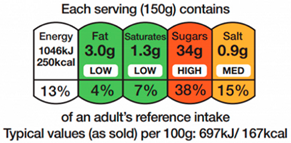 | 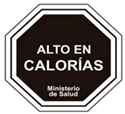 |
| Binary | Ordinal | Cardinal | ||
|---|---|---|---|---|
| Expresses opinion by presence or absence | Divides nutritional score into classes | Expresses information in units | ||
| 3 classes | 5 classes | 10 classes | ||
 |  |  |  |  |
| Words | Numbers | Colours | Ideograms |
|---|---|---|---|
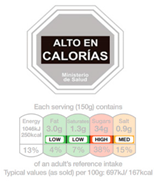 | 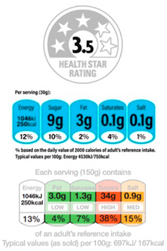 | 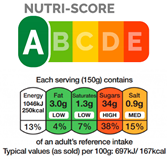 | 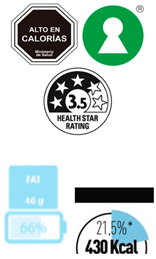 |
| Systems Abbreviations | Directiveness | Scope | Reference Set | Description |
|---|---|---|---|---|
| D-W-R | Diet-Directive | Within-Category | Recommended | 3 coloured signs (one per nutrient) when the nutrient content is healthy in relation to the same food category |
| D-A-R | Diet-Directive | Across-Category | Recommended | 3 coloured signs (one per nutrient) when the nutrient level is healthy in relation to the same food category |
| F-W-R | Food-Directive | Within-Category | Recommended | 1 coloured sign when food is healthy in relation to the same food category |
| F-A-R | Food-Directive | Across-Category | Recommended | 1 coloured sign when food is healthy in relation to all foods |
| F-W-R&W | Food-Directive | Within-Category | Recommended and Warned | 1 coloured sign when food is either healthy or unhealthy in relation to the same category |
| F-A-R&W | Food-Directive | Across-Category | Recommended and Warned | 1 coloured sign when food is either healthy or unhealthy in relation to all foods |
| RI | Non-Directive | Across-Category | Recommended and Warned | Reference Intakes: Percentage of daily-recommended intake values per serving for each nutrient |
| Step 1 | Welcome speech—Facilitators give general instructions regarding the upcoming session. Participants receive EUR 25 to compensate for their attendance. |
| Step 2 | Task instructions—Shopping tasks and the incentive mechanism are read aloud and projected both on a large screen and on each personal computer screen. Participants receive a food catalogue containing 273 food products with no FoPLs attached. |
| Step 3 | Experiment, Stage 1—Participants compose their reference basket. |
| Step 4 | Label presentation—Participants receive another food catalogue that is strictly identical to the previous one, except that a FoPLs is now applied to each food. The facilitator presents the corresponding labelling system. |
| Step 5 | Experiment, Stage 2—Participants compose their label basket. |
| Step 6 | Survey—Participants fill out a survey on socio-demographic characteristics. |
| Step 7 | Draw—One of the two baskets is randomly drawn for actual purchases. |
| Step 8 | Purchase—Participants purchase all products from their selected basket that match the products available in the laboratory. |
| Average Nutrition Score Decrease, as % from Reference to Label Basket (Standard Deviation) | Individual Change in Nutrition Score from Reference to Label Basket Percentage of Participants in Each Category | ||||
|---|---|---|---|---|---|
| −20% < Δ < 0% Improvement | Δ < −20% Large Improvement | Δ = 0% Unchanged | Δ > 0% Degradation | ||
| RI | −10.6% (13.5) b | 76.9% | 19.2% | 7.7% | 15.4% |
| D-W-R | −4.4% (9.2) a | 61.4% | 5.7% | 15.7% | 22.9% |
| D-A-R | −5.2% (15.9) a | 45.3% | 12.0% | 26.7% | 28.0% |
| F-W-R | −9.7% (13.6) b | 81.4% | 13.6% | 5.1% | 13.6% |
| F-A-R | −10.8% (16.0) b | 80.8% | 23.1% | 7.7% | 11.5% |
| F-W-R&W | −13.8% (17.5) b | 72.4% | 34.5% | 3.4% | 24.1% |
| F-A-R&W | −14.6% (20.7) b | 74.0% | 33.3% | 3.7% | 22.2% |
| All systems | −8.7% (15.0) | 68.1% | 17.0% | 12.1% | 19.8% |
| Reference basket | RI | F-W-R | F-A-R | D-W-R | D-A-R | F-W-R&W | F-A-R&W |
| 22.3 | 20.5 | 23.6 | 22.2 | 20.7 | 19.9 | 20.4 |
| Label basket | RI | F-W-R | F-A-R | D-W-R | D-A-R | F-W-R&W | F-A-R&W |
| 20.4 | 20.1 | 22.2 | 21.9 | 19.8 | 18.4 | 19.0 |
| 18.5 | 16.9 | 20.3 | 19.3 | 18.6 | 15.5 | 17.1 |
| 1.4 | 2.6 | 0.7 | 1.9 | 0.9 | 2.3 | 1.0 |
| 0.6 | 0.7 | 1.2 | 0.7 | 0.6 | 0.6 | 0.9 |
© 2020 by the authors. Licensee MDPI, Basel, Switzerland. This article is an open access article distributed under the terms and conditions of the Creative Commons Attribution (CC BY) license (http://creativecommons.org/licenses/by/4.0/).
Share and Cite
Muller, L.; Ruffieux, B. What Makes a Front-of-Pack Nutritional Labelling System Effective: The Impact of Key Design Components on Food Purchases. Nutrients 2020, 12, 2870. https://doi.org/10.3390/nu12092870
Muller L, Ruffieux B. What Makes a Front-of-Pack Nutritional Labelling System Effective: The Impact of Key Design Components on Food Purchases. Nutrients. 2020; 12(9):2870. https://doi.org/10.3390/nu12092870
Chicago/Turabian StyleMuller, Laurent, and Bernard Ruffieux. 2020. "What Makes a Front-of-Pack Nutritional Labelling System Effective: The Impact of Key Design Components on Food Purchases" Nutrients 12, no. 9: 2870. https://doi.org/10.3390/nu12092870
APA StyleMuller, L., & Ruffieux, B. (2020). What Makes a Front-of-Pack Nutritional Labelling System Effective: The Impact of Key Design Components on Food Purchases. Nutrients, 12(9), 2870. https://doi.org/10.3390/nu12092870





